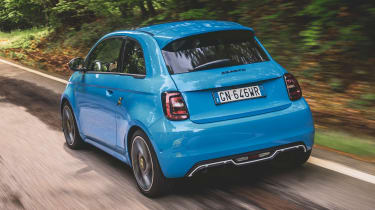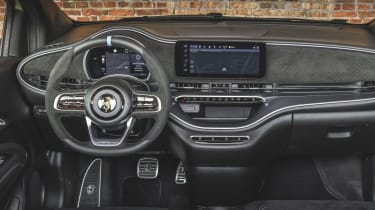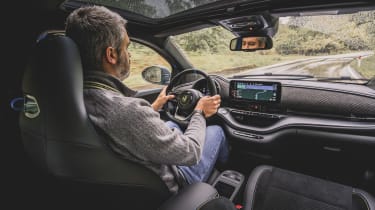New Abarth 500e 2023 review
Abarth goes all-electric with sporty 500e
Verdict:
The new Abarth 500 feels more mature than any previous model from the firm – but the jury’s out on whether that’s a good thing. For some, this more reserved nature will make the car a more credible premium alternative to cars such as the MINI Electric. But others may well find themselves craving more excitement, because the 500 lacks the raw edge of its predecessors – and leaves room for faster, lighter models in the future. Let’s say, then, that the 500 is a flavoursome first taste, but we’re intrigued about what’s to come.
Slowly but surely, all corners of the car market are turning electric. What started as a fuel for big, bulky SUVs, has now trickled down to superminis and even sports cars – plus near enough everything in between. Attempting to leave no stone unturned, Abarth reckons it’s now time for an electric hot hatchback.
As with the fast-dwindling ICE era, its efforts focus on the humble Fiat 500. Taking the EV city car as a base is no bad thing, though – while perhaps not as much fun as a MINI Electric, the latest Fiat strikes a great balance of ride and handling.
Yet Abarth has very much been back to the drawing board for the 500e, binning the standard car’s springs and dampers and tuning the calibration for the steering. It’s fitted uprated brakes front and rear and there’s bespoke Bridgestone Potenza Sport tyres, too.
More reviews
Of course, the Abarth 500e also dons a sportier look with new bumpers and side skirts, a white lower splitter, unique alloy wheels, matte-grey mirror caps and a rear diffuser. Every car also gets new scorpion badges, with added lightning bolts, on the rear panels.
Underneath, you’ll find the same 42kWh battery as in the standard 500, though the myriad changes mean range drops to between 150-164 miles depending on the exact spec. The maximum rapid charge rate is unchanged, at 85kW, good for a 0-80 per cent top-up in around 35 minutes. An 11kW on-board charger means a slower AC charge is possible in a little over four hours – or slightly longer via a more common 7kW wallbox.
Then there’s the motor, boosted from 116bhp to 152bhp and with a new throttle map. Abarth claims the 500e is faster even than the petrol-powered 695 when accelerating from low speeds; it’s a second quicker from 40-60kmh (25-37mph), for example. The maker somehow glosses over the fact it’s half a second slower from 0-62mph.
Yet there’s no denying from the off, the 500e feels alert. That instant electric torque gives the car new character at low revs, with none of the lag you’d associate with the petrol car. But where the 695 keeps pulling past the national speed limit, the EV begins to run out of steam.
However, our drive – both on road and track – took place exclusively in the pouring rain, meaning we weren’t able to exploit the car’s handling quite as we might have liked. The 500e’s wider track and longer wheelbase (versus the 695) contributes to substantially improved stability, but putting down too much power through tight corners or chicanes saw the front wash wide.
The new steering set-up adds more meat to the 500’s featherweight rack, though, and is a highlight of the Abarth driving experience. The Alcantara wheel only adds to this, sitting perfectly in your hands – particularly when driving quickly with your thumbs at 10-to-two.
Those aforementioned suspension and shock upgrades also boost the 500e’s composure. This is a fundamentally stiff chassis, which ensures the new car retains its predecessor’s occasionally bouncy personality, but the edges have been smoothed off. It no longer crashes into potholes, and you’re not constantly battling to keep the car in a straight line on rougher roads. This grown-up personality aligns it more closely with rivals like the MINI than ever before.
The Abarth’s three drive modes are pretty well judged, too. Turismo limits power and ramps up the regenerative braking to offer true one-pedal driving, while Scorpion Track does the opposite. Scorpion Street sits somewhere in the middle, maintaining maximum regen but with full power. This was our chosen setting, even on the circuit section.
And of course, we can’t conclude our driving impressions without at least touching on the Abarth Sound Generator, which the company claims is “one of a kind in the electric hot hatch segment”. We can’t argue with that – the 6,000 hours Abarth engineers spent “analysing and creating the perfect sound” to replicate this car’s petrol predecessors weren’t wasted – but we’re not entirely sure it’s the right solution.
It works via an externally mounted waterproof subwoofer and projects the sound of an old-school Record Monza exhaust – audible for both those inside and outside the car. Bosses say the idea was to “enhance the experience and create a smile”.
The underlying burble at idle isn’t the issue – nor is the way it matches your throttle inputs when driving around town or on rural roads. We’re firm believers that sporty EVs need some kind of sound to replace the revs of a petrol engine, in fact, if only to give you a greater sense of speed and increase engagement. The biggest problem is that it can’t be adjusted on the fly; it’s really quite intrusive at a steady 50mph – almost as if the car is sitting in too high a gear – and can only be switched off at a standstill. Not ideal.
Raise your speed further and it fades into the background, though. At motorway speeds, it’s largely drowned out by the inevitable wind and road noise. It’s just on that middle ground we find it irritating.
Inside, the dashboard is familiar, but there are plenty of unique features to separate the 500e from its Fiat equivalent. The dark headlining gives the Abarth an Mercedes-AMG or BMW M-lite feel, while the 500e-specific sports seats are both supportive and comfortable. Every car also gets a double-stitched steering wheel.
Technology is pretty well catered for. All cars come with a 10.25-inch touchscreen with wireless Apple CarPlay and Android Auto, plus a selection of ‘Performance Pages’ – fun to flick through once or twice, but we don’t see them being of particular use or interest for most buyers – especially as you can switch the drive mode separately via a toggle on the centre console.
Added to this, you get a seven-inch digital instrument cluster – again with Abarth-specific content. It does the job, and can show map directions in your line of sight. But some of the menus are quite complex, and certain settings aren’t always hidden where you’d expect to find them.
Two specs are available to order, with the Scorpionissima launch edition now sold out. Base cars – simply called 500e – come with 17-inch wheels, LED lights, climate control and keyless go, plus the screens and infotainment tech listed above. Prices start from £34,195 – £3k more than the standard Fiat 500 on which it’s based.
Above the 500e sits the all-singing-all-dancing Turismo model, like the one we had the chance to drive. These versions get larger 18-inch wheels – which we think look great, incidentally – plus Alcantara trim inside, a fixed glass roof, wireless phone charging and a parking camera. Every colour apart from white – including the Poison Blue of our test car – is a £600 option.
There’s very little sense in spending too much time talking about practicality. Suffice it to say that this is not a car you’ll buy if you regularly carry people in the back, or often need to load up the boot with bags or belongings.
The Abarth gets a measly 185-litre boot and is three-door only, though there are plans afoot to expand the range, possibly to include a tuned version of the upcoming Fiat 600 crossover. For now, if you want a hot-ish hatchback with a modicum of versatility, we’d suggest looking at the striking Cupra Born.
| Model: | Abarth 500e Turismo |
| Price: | £38,195 |
| Powertrain: | 42kWh battery, 1x e-motor |
| Power/torque: | 152bhp/295Nm |
| Transmission: | Single-speed auto, front-wheel drive |
| 0-62mph: | 7.0 seconds |
| Top speed: | 96mph |
| Range/charging: | 157 miles/85kW, 0-80% in 35 mins |
| On sale: | Now |








